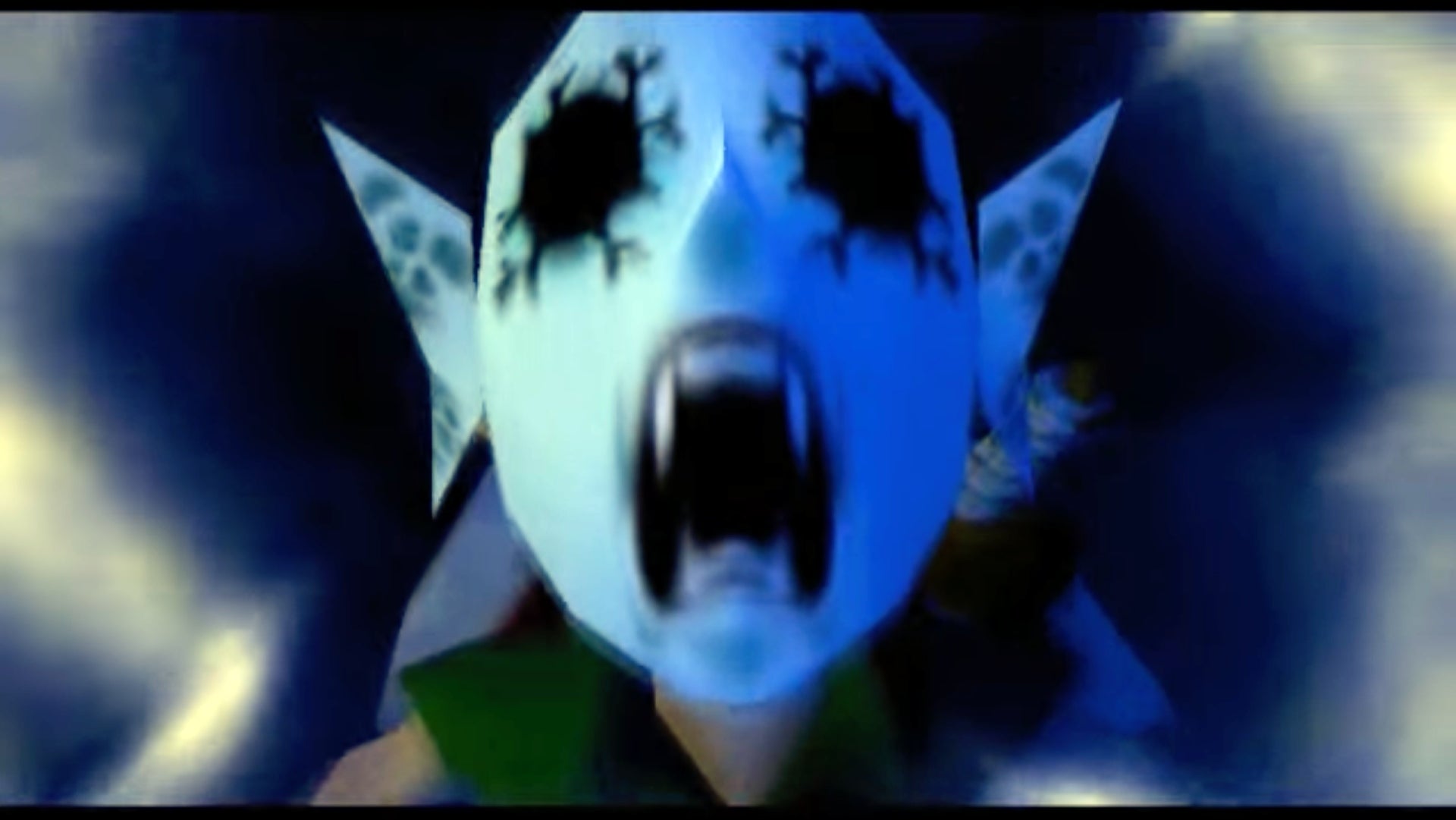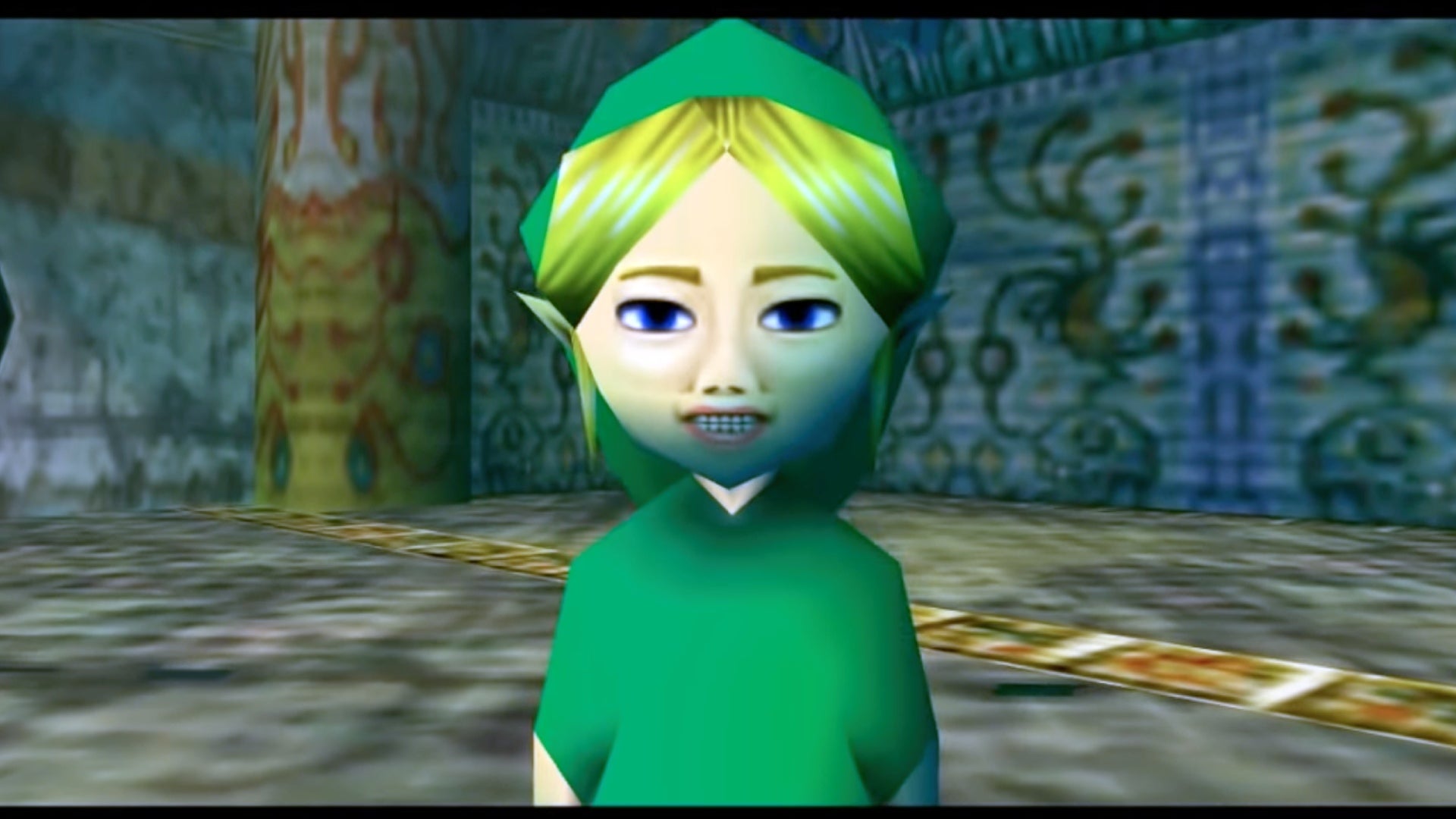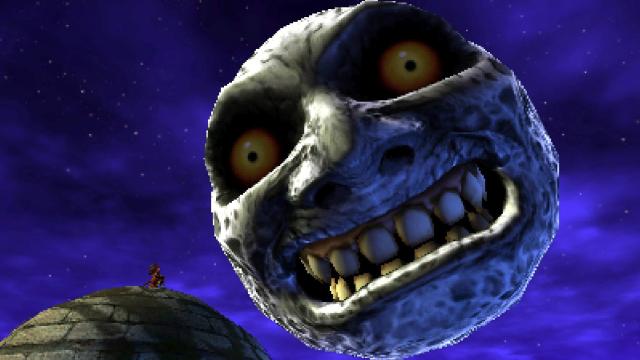The first thing that comes to mind when I think of The Legend of Zelda: Majora’s Mask is that horrifying moon. It’s ominous, always smiling, a reminder that death is an inevitability for everyone. It lingers in the background, like a shadow against a wall, waiting to strike. If, after three days, you fail to save the world, perhaps squandering too much of your time looking around when every second counts, that horrid moon plummets toward Termina. And on impact, everything is blown to smithereens, with Link screaming into oblivion. It’s some real spooky shit.
It’s an image that’s been seared into my brain, one that haunts me to this day, and part of why I believe Majora’s Mask is a horror game.
Released in 2000 on Nintendo 64 (and 2003 on GameCube and 2015 on 3DS and sometime in the future on Nintendo Switch Online), The Legend of Zelda: Majora’s Mask takes place two months after the events of Ocarina of Time. In a quest to find his fairy friend, the chatterbox Navi, Link encounters an imp named Skull Kid who’s possessed by a vengeful spirit that dwells within the mask he’s wearing. Like a bully stealing Halloween candy, Skull Kid jacks Link’s trusty steed Epona. After giving chase, Link plunges into an abyss, falling through a psychedelic darkness before landing in a mysterious yet familiar land called Termina. This kickstarts Link’s haunting journey to stop Skull Kid from enacting more irreparable harm.
Right off the bat, things are terrifying. Not only does he get his shit stolen from him, but Link is also soon transformed entirely against his will. He screams in utter perplexity at the revelation that he’s become some Deku Scrub. The face he now makes could be one of constant pain or sadness, but one thing’s for certain: Link looks like he could “start crying any second now,” as his new fairy companion Tatl puts it early in the game when you come across a sad-looking Deku tree. That tree has quite a reason to be sad. In fact, its tale of woe led to its soul being trapped inside the very mask Link has been forced to wear.
And the screams don’t stop with the first time Link is turned, rather violently by Skull Kid, into a Deku Scrub at the game’s beginning. All throughout Majora’s Mask are…masks. Whenever equipped, Link writhes in agony as his body transforms to match the mask’s visage, whether the result is close to his actual body (Deku) or far from it (Goron). And it happens every single time he puts a mask on, just one of many motifs that situate Majora’s Mask in the realm of horror: The game toys with body horror as Link repeatedly undergoes unpleasant transformations to become someone new, screaming every time. And it’s not lost on me that the masks he wears come from dead people.

The game is all about putting on some kind of face, especially in the midst of death. The townsfolk, in denial of the impending doom bearing down upon them until it’s far too late, continue about their daily lives. Those bound by duty stay on the job, while everyone else plans a freaking carnival — as if that’s not strange. They’re all going to die in three days, dammit! And yet, no matter the face we put on, death is the constant we share. Nowhere is this more emblematic than in Majora’s Mask’s final moments, when the moon comes crashing down.
Read More: Majora’s Mask Is A Game About Death
And what a moment it is! Should you forget about the three-day cycle or just let time run out, an unskippable cutscene plays in the last five seconds. It depicts the moon hurtling toward Termina with its unnerving smile and pointed nose, crushing Clock Town and obliterating everything in seconds. After a moment of darkness, Link emerges, only to be blown away by the explosion. The last things we hear and see are Link’s screams and Majora’s Mask in crackling fire. It’s a striking scene, all exacerbating my fears of global calamity either through climate change (which is worsening) or a collision with an asteroid (which might happen). It also speaks to time’s impermanence, which is scary, too. Time marches on in the same way the game’s moon steadily descends, an unavoidable reality for everyone.
But perhaps the most terrifying thing, aside from that creepy moon and the eerie soundtrack that accompanies the entire game, is what it all could mean. It’s long been discussed that Link might be dead in Majora’s Mask, with Termina serving as a sort of purgatory for his soul to accept his death. I mean, the Hero of Time falls down a long-arse “rabbit hole” inside a tree to get to Termina, a supposed parallel world to Hyrule. He falls for what could be miles, and that psychedelic sequence that plays during the fall indicates some sort of passage. This place is also called “Termina,” which sounds way too close to “terminal.” We should be intimately familiar with that word’s implications, especially given the game’s conclusion if you do nothing. This all suggests to me that it’s either a dream, or that Link is actually dead here. Both notions are troubling.
Further solidifying Termina as a purgatory is the fact that most of its denizens are copies of characters seen in Ocarina of Time’s Hyrule. Whether these are wandering ghosts or just reflections of what Link knows is anyone’s guess.
And then there’s the Elegy of Emptiness, a late-game song you play to spawn heartless and heavy clones of Link. It was always curious to me that you could only create copies of four characters, three of which are dead: Deku Butler’s Son (Deku), Darmani III (Goron), and Mikau (Zora). The fourth is Link, which says one thing to me: He’s absolutely dead. Just look at this freaky, off-putting Link clone. It’s perturbing, with its bizarre smile, static eyes, and its uncanny not-quite-resemblance to a living person.

I was a literal child when I first played this game. I didn’t quite understand everything that was going on, and I certainly didn’t pick up on the subtext at the time, but I knew I was scared whenever I picked up my Majora’s Mask save. The soundtrack, the atmosphere, the enemies — all of it sent chills down my spine. I never finished the game — couldn’t handle the nightmares it was giving me — but its evocative mood and macabre vibes have stuck with me ever since. Even going back to the game, I can’t help but tremble at most of its imagery. Link’s screams in particular reverberate in my mind.
The thing that scared me the most, though? Skull Kid. That mischievous little bastard is more than a menace, as Majora’s Mask slowly erodes his sanity, causing his “pranks” to become increasingly violent throughout the game. It’s Skull Kid who turns Link into a Deku Scrub. It’s Skull Kid who “got rid” of Epona, whatever the hell that means. It’s Skull Kid who summons the moon and sets it on a collision course with Termina. Everything was Skull Kid’s fault, and that kind of power paralysed me.
I’m older and a little braver now, but I’m not sure I could brave Majora’s Mask again. It’s frightening, filled with terrors that belong in a horror movie, making it an uncharacteristic and fascinating release by the usually family-friendly Nintendo. For me, this horror is what defines it. It’s why I remember the game so vividly: because it scared the shit out of me. But more than that, it speaks plainly to our deepest fears, of death and loss and impermanence. We are, after all, always running out of time.

Leave a Reply